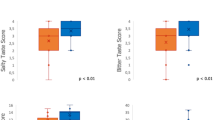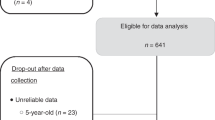Abstract
Background: Primary Sjögren's syndrome (pSS) is a chronic autoimmune disease characterized by inflammatory lymphocytic infiltration of the salivary glands, leading to dryness of the mouth (xerostomia). It has been postulated that xerostomia is the preceding stage for the development of alterations in taste acuity (dysgeusia) in this type of patients.
Objectives: To determine detection and recognition thresholds to the 4 basic tastes (sweet, salty, sour and bitter) in pSS patients and compare them to a control group. To determine if the long-term consumption of chile peppers and spicy Mexican diets had an effect on the taste perception and acuity of the pSS patients.
Setting: This study was done in the Department of Food Science and Technology of the Instituto Nacional de Ciencias Médicas y Nutrición Salvador Zubirán (INCMNSZ), a third-level hospital in Mexico City.
Subjects: The patient group consisted of 21 Mexican females (mean±s.d., age: 53.1±9.8 y) diagnosed with pSS (time of duration of the disease, 8.6±6.6 y, median 7 y, range 1–25 y) who were recruited at the outpatient service of the Department of Immunology and Rheumatology of the INCMNSZ. The control group consisted of 20 healthy nonsmokers age-matched Mexican women (50.3±11.9 y) most of them personnel of the INCMNSZ, and some friends and nonblood relatives to the patients (sisters-in-law) who volunteered to participate in the study.
Interventions: Detection and recognition thresholds were determined by the method of least noticeable differences on three occasions during three nonconsecutive days. Saliva production was determined by Saxon's test on two separate occasions.
Results: Although saliva production was severely reduced in pSS patients (1.35±0.55 ml/2 min, P<0.001) compared to controls (6.26±2.41 ml/2 min), all subjects recognized the 4 basic tastes when these were tested at suprathreshold concentrations. The detection thresholds for the sweet, sour and bitter tastes were higher in pSS patients, as well as the recognition thresholds for the salty, sour and bitter tastes. A relationship between time of evolution of the disease and saliva production with individual thresholds could not be established.
Conclusions: pSS patients exhibited different degrees of dysgeusia depending on the taste being studied, that is, they were mildly dysgeusic for the sweet and salty tastes and clearly dysgeusic for the sour and bitter tastes. Although both pSS patients and controls had consumed ‘typical Mexican diets’ their entire lives, our results showed that the consumption of chile peppers and spicy foods did not have any effect on the taste perception and acuity of the pSS patients.
This is a preview of subscription content, access via your institution
Access options
Subscribe to this journal
Receive 12 print issues and online access
$259.00 per year
only $21.58 per issue
Buy this article
- Purchase on Springer Link
- Instant access to full article PDF
Prices may be subject to local taxes which are calculated during checkout




Similar content being viewed by others
References
Amerine MA & Pangborn RM (1965): Principles of sensory evaluation of food. New York: Academic Press.
Breslin PAS & Beauchamp GK (1997): Salt enhances flavour by suppressing bitterness. Nature 387, 563.
Cermak JM, Papas AS, Sullivan RM, Dana MR & Sullivan DA (2003): Nutrient intake in women with primary and secondary Sjogren's syndrome. Eur. J. Clin. Nutr. 57, 328–334.
Daly LE & Bourge GJ (1991): Interpretation and Uses of Medical Statistics. London: Blackwell Scientific Publications.
Fox RI & Howell F (1986): Oral problems in patients with Sjogren's syndrome. Scand. J. Rheumatol. 61, 194–200.
Fox PC, van der Ven PF, Sonies BC, Weiffenbach JM & Baum BJ (1985): Xerostomia: evaluation of a symptom with increasing significance. J. Am. Dent. Assoc. 110, 519–525.
Henkin RI, Talal N, Larson AL & Mattern FT (1972): Abnormalities of taste and smell in Sjogren's syndrome. Ann. Intern. Med. 76, 375–383.
Jellinek G (1985): Sensory Evaluation of Food. Theory and Practice. Chichester, England: Ellis Horwood Ltd.
Kamath SK (1982): Taste acuity and aging. Am. J. Clin. Nutr. 36, 766–775.
Kelly CA & Foster H (1991): Primary Sjogren's syndrome in North East England: a longitudinal study. Br. J. Rheumatol. 30, 437–442.
Kohler PF & Winter ME (1985): A quantitative test for xerostomia. The Saxon test, an oral equivalent of the Schirmer test. Arthritis Rheum. 28, 1128–1132.
Kolsen-Petersen J (1986): Xerostomia. Scand. J. Rheumatol. 61, 185–189.
Kraus A & Caballero-Uribe C (1992): Raynaud's phenomenon in primary Sjogren's syndrome. Association with other extraglandular manifestations. J. Rheumatol. 19, 1572–1574.
Matsuo R (2000): Role of saliva in the maintenance of taste sensitivity. Crit. Rev. Oral Biol. Med. 11, 216–229.
Montanaro A (1996): Sjogren's syndrome. Immunol. Allergy Clin. North Am 16, 91–105.
Pedersen AM, Bardow A, Jensen SB & Nauntofte B (2002): Saliva and gastrointestinal functions of taste, mastication, swallowing and digestion. Oral Diseases 8, 117–129.
Pedrero DL & Pangborn RM (1989): Evaluación sensorial de los alimentos. Métodos analíticos. Mexico: Alhambra Mexicana.
Soto-Rojas AE, Villa AR, Sifuentes-Osornio J, Alarcón-Segovia D & Kraus A (1998): Oral manifestations in patients with Sjogren's syndrome. J. Rheumatol. 25, 906–910.
ter Borg EJ, Haanen HC, Haas FJ, Bistervels JH, Huisman FW, Kerckhaert JA & Kallenberg CG (2002): Treatment of primary Sjogren's syndrome with D-penicillamine: a pilot study. Neth. J. Med. 60, 402–406.
Tovar AR, Gomez E, Bourges H, Ortiz V, Kraus A & Torres N (2002): Biochemical deficiency of pyridoxine does not affect interleukin-2 production of lymphocytes from patients with Sjogren's syndrome. Eur. J. Clin. Nutr. 56, 1087–1093.
Tsianos EB & Vasakos S (1986): The gastrointestinal involvement in primary Sjogren's syndrome. Scand. J. Rheumatol. 61, 151–155.
van der Reijden WA, Vissink A, Veerman ECI & Nieuw AV (1999): Treatment of oral dryness related complaints (xerostomia) in Sjögren's syndrome. Ann. Rheum. Dis. 58, 465–473.
Vissink A, Schaub RM, Van Rijn LJ, Gravenmade EJ, Panders AK & Vermey A (1987): The efficacy of mucin-containing artificial saliva in alleviating symptoms of xerostomia. Gerodontology. 6, 95–101.
Vitali C, Bombardieri S, Moutsopoulos HM et al. (1996): Assessment of the European classification criteria for Sjogren's syndrome in a series of clinically defined cases: results of a prospective multicentre study. The European Study Group on Diagnostic Criteria for Sjogren's syndrome. Ann. Rhem. Dis. 55, 116–121.
Weiffenbach JM & Fox PC (1993): Odor identification ability among patients with Sjogren's syndrome. Arthritis Rheum. 36, 1752–1754.
Weiffenbach JM, Fox PC & Baum BJ (1986): Taste and salivary function. Proc. Natl. Acad. Sci. USA 23, 6103–6106.
Weiffenbach JM, Schwartz LK, Atkinson JC & Fox PC (1995): Taste performance in Sjogren's syndrome. Physiol. Behav. 57, 89–96.
Acknowledgements
We thank Arnoldo Kraus of the Department of Immunology and Rheumatology of the INCMNSZ for the recruitment of pSS patients and Claudia García for her work with the patients, Sergio Ponce-de-León of the Unit of Clinical Epidemiology of the INCMNSZ and Daniel Pedrero of ‘Penta Sensorial-México’ for their help in the analysis of data and Robert C Lindsay of the Department of Food Science, University of Wisconsin-Madison, for his critical review of the manuscript.
Author information
Authors and Affiliations
Contributions
Guarantor: F. Enrique Gomez
Contributors: FEG and LCN contributed equally to this work. FEG carried out literature review, designed and coordinated the project and interpreted the data. LCN carried out literature review and was responsible for the sensory test evaluation. JCML designed, coordinated and oversaw the study and is primarily responsible for the sensory evaluation facilities. HB contributed in the design of the study. All authors contributed to writing the manuscript.
Corresponding author
Rights and permissions
About this article
Cite this article
Gomez, F., Cassís-Nosthas, L., Morales-de-León, J. et al. Detection and recognition thresholds to the 4 basic tastes in Mexican patients with primary Sjögren's syndrome. Eur J Clin Nutr 58, 629–636 (2004). https://doi.org/10.1038/sj.ejcn.1601858
Received:
Revised:
Accepted:
Published:
Issue Date:
DOI: https://doi.org/10.1038/sj.ejcn.1601858
Keywords
This article is cited by
-
Chemosensory dysfunction in primary Sjögren’s syndrome: a topical review
Clinical Rheumatology (2023)
-
To Detect and Reject, Parallel Roles for Taste and Immunity
Current Nutrition Reports (2021)
-
Sodium restriction improves the gustatory threshold for salty taste in patients with chronic kidney disease
Kidney International (2009)



